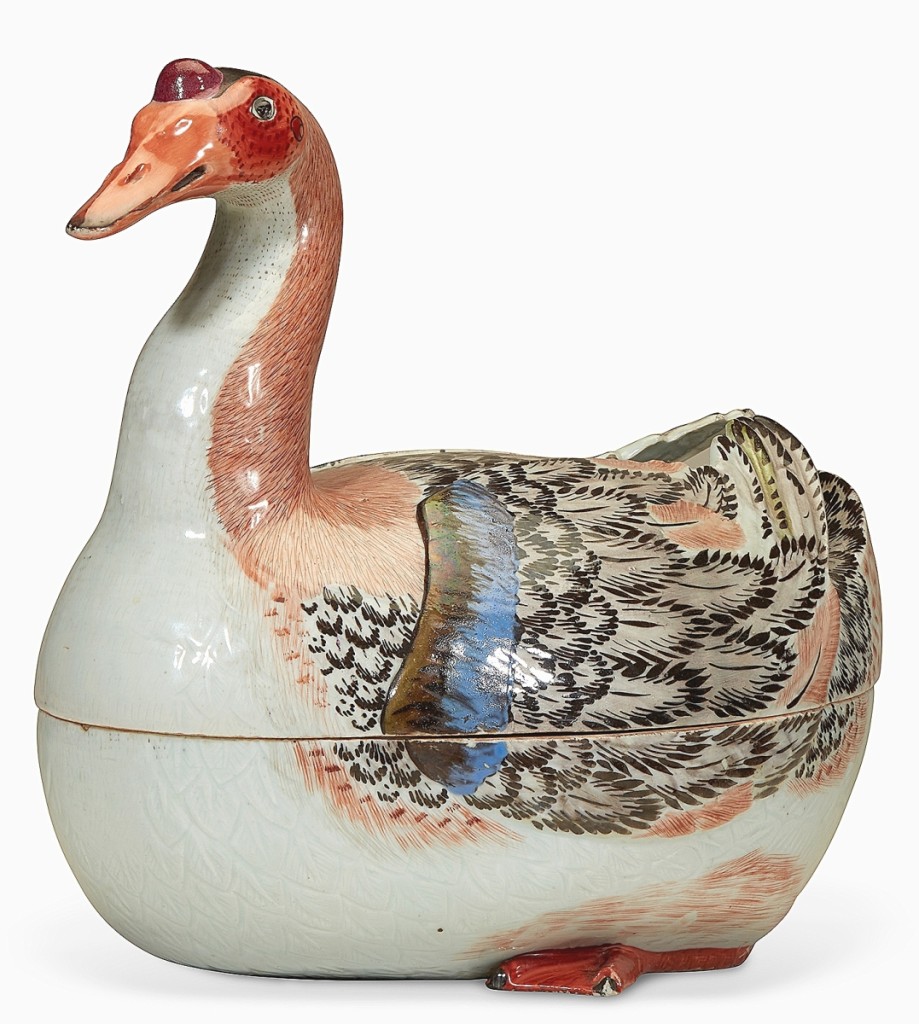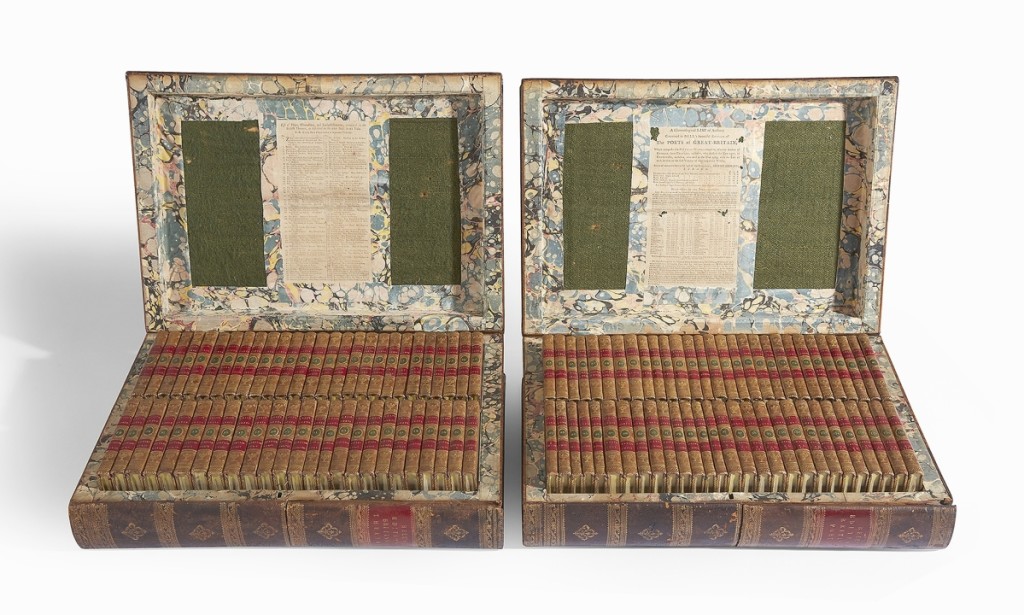
Topping the sale was this Chinese export porcelain tureen in the form of a goose, Qing dynasty, Qianlong period, circa 1760s, that brought $62,500 from an international bidder on the phone ($60/80,000).
Review by Madelia Hickman Ring, Catalog Photos Courtesy Freeman’s
PHILADELPHIA – Tired of working from home, barred from international travel or simply yearning to spread your wings? Freeman’s has created a new sale – “The Age of Exploration: Travel & Discovery Through the Centuries” – to tempt buyers across multiple categories for whom the world is a playground of history and exploration.
“We were looking at ways to re-curate our offerings to appeal to a wider audience,” said Tessa Laney, Freeman’s head of department for British & European furniture and decorative arts and the head of sale for a format that cross pollinates with works from other departments like Asian art, books and manuscripts and fine art. “We wanted to capture cross-over appeal where a single collector might be interested in multiple categories. At a time when people can’t travel, we wanted to offer a theme for armchair travelers. The sale performed really well and we are very pleased.”
This inaugural auction was small but nonetheless delivered impactful results. Of the 150 lots on offer, 89 percent found buyers and the sale total exceeded $370,000, achieving 94 percent of its aggregate presale value. Buyers represented 18 countries worldwide, with 52 percent of successful buyers having never previously bid at Freeman’s. Nearly 60 percent of the lots sold went to online buyers, with phone bidders acquiring 26 percent of the lots and absentee bidders prevailing on three percent of the lots sold.

The second highest price in the sale — $30,000 from a private American collector bidding on the phone — was this 109-volume set of Bell’s Edition: The Poets of Great Britain Complete from Chaucer to Churchill Edinburg: Apollo Press, 1776-82 ($10/15,000).
The sale was divided into four discrete but evocative sections. Two dozen lots of books, maps, ship paintings and models, globes and other navigational objects made up ‘Seafaring & Navigation,” while another 50 lots of Chinese export works, British and European furniture and decorative arts and rugs comprised the section “Travel & Trade with the Middle & Far East.” About 25 lots of architectural models, prints, travel posters and porcelains were grouped under the topic, “Grand Tour.” The sale concluded with more than 120 canes that were grouped into 50 lots of “Mechanical & Metamorphic Walking Sticks” from the collection of independent film director, Larry Clark.
Flying into the lead with global interest and bringing $62,500 from a buyer in the United Kingdom bidding on the phone was a mid-Eighteenth Century Qing dynasty Chinese export porcelain goose-form tureen. It had been consigned to Freeman’s from a private Main Line, Philadelphia collection, who had acquired it in 1988 from New York City dealer Fred B. Nadler. Freeman’s catalog noted the naturalistic modeling and fine details, citing comparable examples offered at auction in the past 20 years and relating it to similar ones illustrated in Porcelain of the East India Companies by Michel Beurdeley and China for the West, vol. II by David Howard and John Ayers.
A pair of diminutive Chinese export porcelain tureens in the form of nesting partridges, also Qing dynasty, came from the same Main Line, Philadelphia estate as the goose tureen. The pair sold for $8,750 to the same buyer who purchased the goose tureen. Rounding out Chinese export porcelain offerings was a Nineteenth Century reticulated basket on stand from a different Philadelphia collection that saw international interest but ultimately sold to a private collector in the United States, bidding online, for $5,000.

A trade buyer in the United States, bidding on the phone against several competing phone bidders, won this large Italian Grand Tour micromosaic plaque, circa 1850-60 that measured 10¾ by 13½ inches in the parcel-gilt ebonized wood frame and depicted a view of the Roman Forum. It nearly quadrupled its low estimate to sell for $15,000 ($4/6,000).
A rare complete first edition set of John Bell’s Poets of Great Britain, published in Edinburg by Apollo Press between 1776 and 1782 and featuring 109 volumes complete in their two original traveling library cases brought $30,000, double the lot’s high estimate. According to Darrin Winston, head of Freeman’s books and manuscripts department, the set was not only rare but it was also “essentially unread,” with each volume featuring the Eighteenth Century engraved bookplate of Melicent Ballard. A private collector in the United States competed by phone for the lot, prevailing against international and American competition online and on the phone as well as absentee bids.
A second edition atlas of Ptolemy’s Geography by Gerard Mercator (1512-1594), published in Cologne in 1584, had condition issues but was in an untouched state of preservation and soared to close at $8,125 from a trade buyer. According to Winston, the map had been acquired in a box lot for about $50 by a collector whose friends thought it might be valuable and encouraged him to bring it to Freeman’s. “He’s very happy with the result,” Winston said. A trade buyer also acquired a framed map of China by Abraham Ortelius, published by John Norton in London in 1606, for $5,000.
If the results of this sale are any indication, items that evoke the concept of the “grand tour” are perennial favorites among collectors. Leading the section was an Italian micromosaic plaque, circa 1850-60, that depicted a view of the Arch of Septimius Severus, the Temple of Vespasian and Titus, and the Temple of Saturn in the Roman Forum, all in a parcel-gilt ebonized wooden frame. According to Laney, who was on the phone with the American trade buyer who paid $15,000 for it, the plaque attracted considerable interest, both from the United States and abroad and several phone lines were employed while it crossed the block.

Federico del Campo’s (Peruvian, 1837-1927) “Street Scene in Venice” from 1892 sold to the same phone bidder who acquired the Grand Tour micromosaic plaque, for $15,000 ($10/15,000).
Several lots of architectural models were consigned by Piraneseum, a San Francisco Bay Area retailer and private museum that specializes in architectural paintings and models from the Seventeenth, Eighteenth and Nineteenth Century. A circa 1870s Italian alabaster model of the San Giovanni Baptistry in Pisa brought $5,000 from a buyer in the United Kingdom bidding on the phone. Bringing $4,688 from an online bidder was a circa 1830 Italian Grand Tour rosso antico and nero antico marble model of Trajan’s Column in Rome, while two French Grand Tour patinated bronze models of the Colonnes Vendôme and Juillet, both by Frères LeBlanc, Paris, circa 1860, sold in a post-auction transaction to a buyer in the Midwest for $4,750.
The “Grand Tour” section featured more than just models, as evidenced by “Street Scene in Venice” by Federico del Campo (Peruvian, 1837-1927), done in oil on canvas in 1892 that measured 22 by 18 inches and had provenance to the Gratz Gallery in Doylestown, Penn.; it sold for $15,000 to the same buyer who acquired the micro-mosaic plaque for $15,000.
Of the dozen lots of rugs and carpets in the sale, two in particular saw noteworthy results. An early Twentieth Century Bijar carpet that measured nearly 8 by 17 feet more than tripled its high estimate to sell to an American trade buyer bidding online for $9,375. The other – an early Twentieth Century Oushak carpet – measured approximately 10 by 14 feet, realized $7,188 and more than three times its low estimate from a private collector in the United Kingdom bidding on the phone.

“That was a really stunning carpet,” Laney said of this nearly 8-by-17-foot Bidjar carpet from the first quarter of the Twentieth Century that outperformed expectations. It brought $9,375 from an American trade buyer bidding online ($2/3,000).
A Victorian brass and ebonized wood armillary sphere with an octagonal base set with a compass was, in Laney’s words, “emblematic of the spirit of exploration and travel” that she wanted the sale to convey. It sold to a phone bidder from The Netherlands who specializes in scientific instruments and navigational objects for $5,000, double its low estimate.
The cane collection of Larry Clark nearly doubled its presale expectations, with all but three lots selling. The collection attracted two very active bidders who competed on the phones, one international, the other from the United States, but Laney said bidders online and on the phone were also successful. Topping the offerings was a Spanish silver and macassar weaponized cane that brought $4,875 from an online bidder who purchased several canes. A Remington nickel silver-mounted gutta percha and ebonized wood single-shot shotgun cane, dated 1872, with the handle the form of a dog’s head, sold to a trade buyer from the United States.
Freeman’s next “Art of Exploration” sale has not been scheduled.
Prices quoted include the buyer’s premium as reported by the auction house.
Freeman’s is at 2400 Market Street. For more information, www.freemansauction.com or 215-563-9275.





















